Please watch my Termite Youtube Video
When having an inspection done, make sure the inspector or pest inspector has a license,” Marko Vovk, Ambassador’s certified inspector is state licensed”. Ohio requires a state license for wood-destroying insect inspectors who inspect houses for real estate transactions. As part of the licensing process, inspectors must attend training sessions, take state tests, and pay state fees. Marko E. Vovk has met these requirements and is in good standing with all relevant entities.
Marko E. Vovk the home inspector will look for wood destroying insects and document them on the home inspection. This is generally done during the home inspection. We do not charge for this. Although we are licened to perform WWI certificaiton repots, we choose no to do these. If your bank requires a FHA Certificaion or other certifcaion report, call a pest company.
Extermination companies usually charge aroun d $135 plus tax. Extermination companies may also be a bit bias and try to sell some service while at the inspection. It is not common for an exterminator to find one dead ant and recommend the home be treated for ants. This ant could have very well been a straggler. Home inspectors do not try to sell extermination services. It is advised that you obtain a non biased opinion. termite, ant, powder post beetles and pest inspecton with a paid home inspection and paid radon test.
WHAT WE INSPECT FOR:
During our wood boring insect elaluation, we are concerned will all pests, but we report on only the wood destroying species that are common in the Cleveland Ohio market.
The big four Ohio wood destroying creatures are as follows:
|
|
Carpenter Ants |
|
|
Termites |
|
|
Powder Post Beetles |
|
|
Carpenter Bees and Woodpeckers |
CARPENTER ANTS
Carpenter Ants are often referred to as “big black ants” or “big black fuzzy ants“. Although some species are not black. Most people think of carpenter ants as being rather large. Did you know that there are twenty plus possible sizes for carpenter ants?
 Larger ants indicate a more mature colony: one that has been located in the same area for some time. Smaller ants could be newer colonies, from satellite colonies or third generation Carpenter Ants. A large Carpenter Ant colony could also have several smaller satellite colonies.
Larger ants indicate a more mature colony: one that has been located in the same area for some time. Smaller ants could be newer colonies, from satellite colonies or third generation Carpenter Ants. A large Carpenter Ant colony could also have several smaller satellite colonies.
Carpenter Ants are very common in areas that are wet of have a high water table.
These pests seek out high moisture areas in and around structures. Carpenter Ants usually nest either in damp wood or close to it. Leaking windows, roofs, plumbing pipes, interstitial condensation caused by building science, garages, crawl spaces, stumps, roofs, windows, and big trees are their favorite nesting grounds. Wood found to be infested with Carpenter Ants is usually damaged also by wood rot. Rot is caused by microbial or fungal organisms. These insects smooth out the wood with their chewing mouthparts and then live within these galleries. Unlike Termites, Carpenter Ants cannot digest the cellulose in wood and thus cannot cause the same level of damage that termites are capable of.
The inspector will check for many of the following conditions during the inspection: leaks from the roof or gutters, improperly caulked windows and doors (including patio doors), water leaking around window AC units, fungal reservoir locations, plumbing leaks, leaking dishwashers, leaking washing machines, Poorly caulked bathtubs, shower pan leaks, sink drains or poorly grouted tile showers.
Other items the inspector will look for include firewood piles in or near a structure, infested railroad ties, or other decorative wood such as mulch, decks, overhanging tree limbs, etc.
In the upper image, a carpenter ant satellite has moved into an attic and taken over a yellow jacket nest. I only found this satellite by following the ants on the exterior
TERMITES
Termites are the most economically important insect in the United States. Their destructive force is simply incredible and they cause ONE BILLION DOLLARS worth of damage every year. As homeowners, we tend to forget that termites attacking our homes are simply performing their natural function of breaking down wood. Along with fungal decay, termites are common in forests as recyclers of wood.
There are several species of termites in the United States. The most common ones are the Subterranean, Dry wood and Formosan termites. This spices is very common throughout the USA and found in all of our Cleveland suburbs. What makes these insects so destructive is their ability to digest (EAT) the wood fiber or cellulose. The actual digestion of wood is performed in the gut of a termite by very small protozoa living there. The protozoa are passed on from generation to generation by the feeding of termite fecal matter from adults to young termites.
Is it a Termite or an Ant?
One of the most common questions we get is when a winged insect is found in the home. Both termites and ants may have a swarming stage or reproductive that has wings. The public calls these “flying ants”. We will provide you several characteristics to help you to make a determination when you see these so-called “FLYING ANTS”:
| Termite Reproductive: | |
|
|
The wings are paddle shaped and are twice the length of the body. All four wings are the same size. |
|
|
The antennae are straight and short. |
|
|
The body has only two components: head and (ribbed) abdomen as one continuous piece. (The body is somewhat straight looking. |
| Ant Reproductive: | |
|
|
The wings are somewhat pointed and only slightly longer than the length of the body. Two sets of wings that are two different sizes. |
|
|
The antennae are curved. |
|
|
The body has three distinct components: head, thorax (mid-section), and abdomen. (The body is somewhat curvy looking.) |
 Subterranean termites have the ability to adjust the depth of their colony (nest) in soil depending on temperature and moisture requirements. A colony may be 3-4 feet below grade and 18-20 feet deep in the ground. The ground serves as a protection against extreme temperatures and provides a moisture. Termites reach wood or cellulose materials above ground by constructing and traveling through earthen (mud) tubes or tunnels. The mature colony consists of three castes: a) reproductive (king and queen), b) soldiers, and c) workers. It takes about 4 to 5 years for a colony to reach its maximum size and it may consist of 60,000 to 200,000 workers.
Subterranean termites have the ability to adjust the depth of their colony (nest) in soil depending on temperature and moisture requirements. A colony may be 3-4 feet below grade and 18-20 feet deep in the ground. The ground serves as a protection against extreme temperatures and provides a moisture. Termites reach wood or cellulose materials above ground by constructing and traveling through earthen (mud) tubes or tunnels. The mature colony consists of three castes: a) reproductive (king and queen), b) soldiers, and c) workers. It takes about 4 to 5 years for a colony to reach its maximum size and it may consist of 60,000 to 200,000 workers.
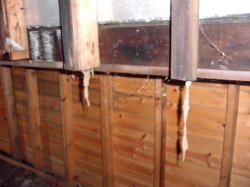 Reproductive: In spring and fall, the winged males and females emerge from their parent colonies to leave for new ones. This activity is known as swarming. Thousands of winged reproductive, which are dark brown or brownish black, leave their home. The swarmers are weak flyers and, unless aided by wind, fly only short distances. Many of them are eaten by birds, spiders, ants, and other predators. Survivors return to the ground and shed their wings. The wingless males and females pair off and hunt for a food source. They dig soil near wood, enter the chamber, and seal the opening. After mating, the queen begins laying eggs. The royal queen is known to survive up to 20 plus years.
Reproductive: In spring and fall, the winged males and females emerge from their parent colonies to leave for new ones. This activity is known as swarming. Thousands of winged reproductive, which are dark brown or brownish black, leave their home. The swarmers are weak flyers and, unless aided by wind, fly only short distances. Many of them are eaten by birds, spiders, ants, and other predators. Survivors return to the ground and shed their wings. The wingless males and females pair off and hunt for a food source. They dig soil near wood, enter the chamber, and seal the opening. After mating, the queen begins laying eggs. The royal queen is known to survive up to 20 plus years.
 Eggs: The fertilized female usually only deposits 6 to 20 eggs during the first six months following the swarming flight. She may lay over 60,000 eggs in her lifetime. Eggs are yellowish white and hatch after incubating 50 to 60 days.
Eggs: The fertilized female usually only deposits 6 to 20 eggs during the first six months following the swarming flight. She may lay over 60,000 eggs in her lifetime. Eggs are yellowish white and hatch after incubating 50 to 60 days.
 Workers: The first brood of newly hatched nymphs also known as young termites. These young nymphs develop into workers. Full-grown workers are soft-bodied, wingless, blind, and appear to be creamy white. In early stages of life, they are fed predigested food by the king and queen. Once workers are able to digest cellulose, they begin working and providing nutrients for the entire colony. At this time, the king and queen cease feeding on cellulose. The workers now undertake all the labor in the colony such as obtaining food, feeding other colony or cast members. The workers excavating wood for chambers, and construct tunnels. Workers mature within a year and can live from three to 5 years.
Workers: The first brood of newly hatched nymphs also known as young termites. These young nymphs develop into workers. Full-grown workers are soft-bodied, wingless, blind, and appear to be creamy white. In early stages of life, they are fed predigested food by the king and queen. Once workers are able to digest cellulose, they begin working and providing nutrients for the entire colony. At this time, the king and queen cease feeding on cellulose. The workers now undertake all the labor in the colony such as obtaining food, feeding other colony or cast members. The workers excavating wood for chambers, and construct tunnels. Workers mature within a year and can live from three to 5 years.
Soldiers: Soldiers are creamy white, soft-bodied, wingless, and are blind. The head of the soldier is large and enormously elongated, brownish, hard, and equipped with two very strong jaws. Workers must feed soldiers, as they are unable of feeding themselves. They are less numerous than workers and their sole function is to defend the colony against invaders. Ants are usually the most common termite invader. Soldiers mature within a year and can live up to 5 years.
CLICK HERE to download a gallery of termites and damage.
Powder Post Beetles: The powder post beetles include wood boring beetles from three families, the Lyctidae or true powder post beetles, the Anobidae or deathwatch beetles and the Bostrichidae, the branch and twig borers (sometimes called false powder post beetles).
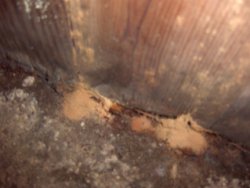 The larvae of these powder post beetles feed on cellulose in the wood and they cause extensive damage to wood in structures and homes. Once again, moisture plays a key role in attack from these pests. These pests reduce the wood to a fine powder. This is where the name power comes from in the name powder post beetle. Holes left by emerging beetles are about 1/8″ in diameter and round. They are sometimes called “shotholes.” A tool such as an awl can be helpful in determining the extent of damage. If the awl pokes in easily and deeply, the wood may be severely damaged.
The larvae of these powder post beetles feed on cellulose in the wood and they cause extensive damage to wood in structures and homes. Once again, moisture plays a key role in attack from these pests. These pests reduce the wood to a fine powder. This is where the name power comes from in the name powder post beetle. Holes left by emerging beetles are about 1/8″ in diameter and round. They are sometimes called “shotholes.” A tool such as an awl can be helpful in determining the extent of damage. If the awl pokes in easily and deeply, the wood may be severely damaged.
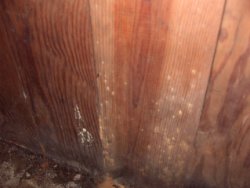 Eggs are layed in cracks, crevices, pores, and old emergence holes in wood. Sometimes the eggs are layed in tunnels made by females. Small larva hatch from eggs and burrow into the wood. They continue feeding and growing to maturity when they burrow toward the surface and pupate. These adults emerge from the pupa and continue the tunnel to the surface.
Eggs are layed in cracks, crevices, pores, and old emergence holes in wood. Sometimes the eggs are layed in tunnels made by females. Small larva hatch from eggs and burrow into the wood. They continue feeding and growing to maturity when they burrow toward the surface and pupate. These adults emerge from the pupa and continue the tunnel to the surface.
Adults leave the wood, mate, and then the females usually return to lay eggs. Exit holes and sawdust from beetles burrowing out are the first symptoms noticed. Tapping on the timber releases the fine power forming the holes. Depending on the type of powder post beetle and the species, the life cycle may range from three months to seven years.
An active infestation will have accumulating sawdust in piles near holes or on the floor below, Sometimes you can see the beetles crawling on the wood, or you may hear a ticking sound that is made by certain larvae. If there is no active infestation, treatment generally is not needed.
CARPENTER BEES AND WOODPECKERS
Carpenter bees are large (1-inch) black and yellow bees, which become active usually in early spring. They resemble bumblebees but do not live in colonies. They have fewer hairs and have a shiny black abdomen. Additionally, no pollen sacs exist on the hind legs. They appear around homes, are a nuisance, and damaged homes. It is very rare to be stung by a carpenter bee. The nests, if left untreated, will result in extensive structural damage and will result in costly repairs soon. The female will go in and out of the nest so patience will show where the entrance is. Killing individual bees with a liquid insecticide will not destroy the bee’s young larva.
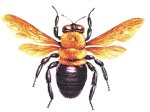 Carpenter bees get their name from their ability to drill through nice round holes in wood and nest in it. Their drilling will create a near perfect hole roughly 1/2 inch in diameter. This hole is usually located on the underside of any wood surface including siding, decks, soffit, window trim, window frames overhangs, fence posts, and fascia
Carpenter bees get their name from their ability to drill through nice round holes in wood and nest in it. Their drilling will create a near perfect hole roughly 1/2 inch in diameter. This hole is usually located on the underside of any wood surface including siding, decks, soffit, window trim, window frames overhangs, fence posts, and fascia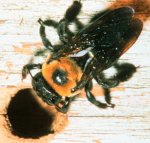 boards. The entrance holes appear to be only an inch or two deep. These small holes lead to large long galleries. The female will turn 90 degrees and bore a channel from 6 inches to as long as four feet. This gallery serves as a main corridor from which she will drill small chambers a few inches deep. These chambers become egg spaces. She will deposit an egg, bring in some food, and then cover the egg.
boards. The entrance holes appear to be only an inch or two deep. These small holes lead to large long galleries. The female will turn 90 degrees and bore a channel from 6 inches to as long as four feet. This gallery serves as a main corridor from which she will drill small chambers a few inches deep. These chambers become egg spaces. She will deposit an egg, bring in some food, and then cover the egg.
The male carpenter bee that is flying around guarding the nest has no stinger. Only the female can sting.
Now it is time for the woodpecker. The woodpecker family is quite extensive. The bottom line is the woodpecker pecks the wood looking for the juicy larva that exist in the carpenter bee galleries.

In this image, you can see the holes created
by the woodpecker searching for the larva.
CALL MARKO E. VOVK, FROM AMBASSADOR,
TO PERFORM YOUR HOME INSPECTION
216-924-8378 cell | 216-431-8378 office and voice mail